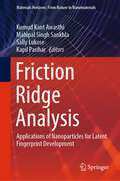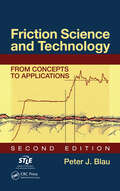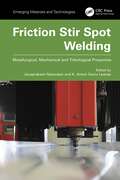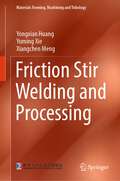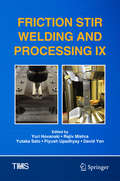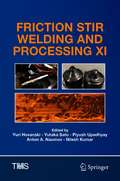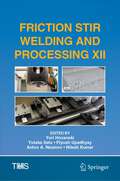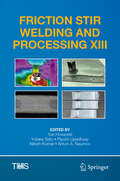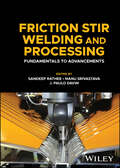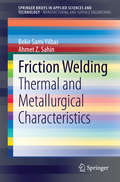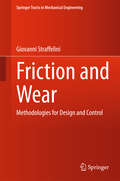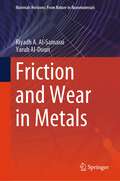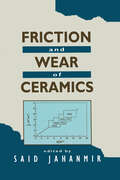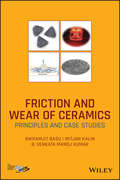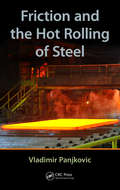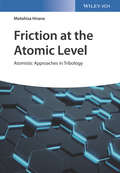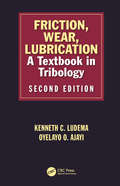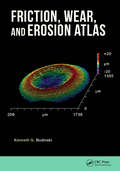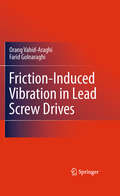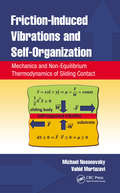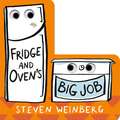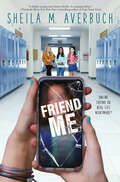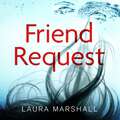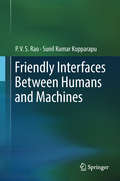- Table View
- List View
Friction Ridge Analysis: Applications of Nanoparticles for Latent Fingerprint Development (Materials Horizons: From Nature to Nanomaterials)
by Kumud Kant Awasthi Mahipal Singh Sankhla Sally Lukose Kapil PariharThe book presents emerging techniques for the development of latent fingerprint on various surfaces using nanotechnology. It explores the use of nanoparticles for the development of fingerprints. Various topics covered in this book include chemistry of nanomaterials for finger printing, quantum dots in fingerprinting, florescent nanoparticles in fingerprinting, nanocomposite and hybrid materials for fingerprints, carbon-based nanomaterial, silver and gold nanoparticles development of fingerprint, zinc oxide nanoparticles, silica nanoparticles for development of fingerprints, etc. Given the contents, the book will be highly useful for the students, researchers and professionals working in the areas of forensic science and nanotechnology.
Friction Science and Technology: From Concepts to Applications, Second Edition
by Peter J. Blau"Should have broad appeal in many kinds of industry, ranging from automotive to computers-basically any organization concerned with products having moving parts!"-David A. Rigney, Materials Science and Engineering Department, Ohio State University, Columbus, USAIn-Depth Coverage of Frictional ConceptsFriction affects so many aspects of daily l
Friction Stir Spot Welding: Metallurgical, Mechanical and Tribological Properties (Emerging Materials and Technologies)
by Jeyaprakash Natarajan K. Anton Savio LewiseFriction Stir Spot Welding offers an introduction to friction stir spot welding (FSSW) between both similar and dissimilar metals and materials. It explains the impact of the interlayer in FSSW of different metals with regard to mechanical, metallurgical, wear, thermo-mechanical, and chemical characteristics.Emphasizing the impact of interlayer on FSSW of different metals, this book discusses the influence of the interlayer in the process as a new technique. Using aerospace and automotive structures as examples, the book explains how their components successfully employ materials like dissimilar aluminium alloys, yielding increased electrical, thermal, and mechanical characteristics. It also considers the reinforcement, effect of tool geometry, wettability, and corrosion behavior of joints.This book is intended for mechanical, materials, and manufacturing professionals, researchers, and engineers working in the field of FSSW.
Friction Stir Welding and Processing (Materials Forming, Machining and Tribology)
by Yongxian Huang Yuming Xie Xiangchen MengThis book introduces the principles and characteristics of friction stir welding and processing. Based on the inherent issues of friction stir welding, such as back support, weld thinning, and keyhole defects, the book summarizes innovative technologies related to solution strategies and presents a wide range of examples. It introduces the advantages and joining mechanism of friction stir welding in the joining of dissimilar materials and explains the importance of combining metallurgical bonding and mechanical joining. It also includes the characteristics of friction stir processing in terms of microstructure refinement, mechanical properties, surface modification, and the preparation of composites. This book is of interest to a broad readership in various fields of materials science and engineering.
Friction Stir Welding and Processing IX
by Yuri Hovanski Rajiv Mishra Yutaka Sato Piyush Upadhyay David YanThis books presents a current look at friction stir welding technology from application to characterization and from modeling to R&D. It is a compilation of the recent progress relating to friction stir technologies including derivative technologies, high-temperature applications, industrial applications, dissimilar alloy/materials, lightweight alloys, simulation, and characterization. With contributions from leaders and experts in industry and academia, this will be a comprehensive source for the field of Friction Stir Welding and Processing.
Friction Stir Welding and Processing XI (The Minerals, Metals & Materials Series)
by Nilesh Kumar Yuri Hovanski Yutaka Sato Piyush Upadhyay Anton A. NaumovThis collection presents fundamentals and the current status of friction stir welding (FSW) and solid-state friction stir processing of materials, and provides researchers and engineers with an opportunity to review the current status of the friction stir related processes and discuss the future possibilities. Contributions cover various aspects of friction stir welding and processing including their derivative technologies. Topics include but are not limited to: • derivative technologies • high-temperature lightweight applications • industrial applications • dissimilar alloys and/or materials • controls and nondestructive examination • simulation • characterization
Friction Stir Welding and Processing XII (The Minerals, Metals & Materials Series)
by Nilesh Kumar Yuri Hovanski Yutaka Sato Piyush Upadhyay Anton A. NaumovThis collection presents fundamentals and the current status of friction stir welding (FSW) and solid-state friction stir processing of materials and provides researchers and engineers with an opportunity to review the current status of the friction stir related processes and discuss the future possibilities. Contributions cover various aspects of friction stir welding and processing including their derivative technologies. Topics include, but are not limited to:• Derivative technologies • High-temperature applications • Industrial applications • Dissimilar alloys and/or materials • Lightweight alloys • Simulation • Characterization • Non-destructive examination techniques
Friction Stir Welding and Processing XIII (The Minerals, Metals & Materials Series)
by Nilesh Kumar Yuri Hovanski Yutaka Sato Piyush Upadhyay Anton A. NaumovThis volume presents fundamentals and the current status of friction stir welding (FSW) and solid-state friction stir processing of materials and provides researchers and engineers with an opportunity to review the current status of the friction stir related processes and discuss the future possibilities. Contributions cover various aspects of friction stir welding and processing including their derivative technologies. Topics include but are not limited to: Additive friction stir technologies Friction stir extrusion technologies High temperature applications Industrial applications Friction stir spot technologies Dissimilar alloys and materials Lightweight alloys Simulation, characterization, and non-destructive examination techniques
Friction Stir Welding and Processing: Fundamentals to Advancements
by J. Paulo Davim Sandeep Rathee Manu SrivastavaA single source of information on the fundamental concepts and latest research applications of friction stir welding and processing Friction Stir Welding and Processing: Fundamentals to Advancements provides concise yet comprehensive coverage of the field of friction stir welding, with an eye toward future research directions and applications. Throughout the book, case studies provide real-world context and highlight applications for various engineering sectors. With contributions from an array of leaders in the field, Friction Stir Welding and Processing provides readers with a single source of information on all aspects of FSW and FSP. After explaining the fundamentals of friction stir welding (FSW) and its variants, the book discusses composite fabrication techniques using friction stir processing (FSP). Different types of friction techniques are covered, as is the equipment used. Detailed characterization of samples and composites are included. Additional topics discussed include the impact of FSW on the economics of production, methods for coupling FSW/FSP with additive manufacturing, composite fabrication, and process-property relationships. Master the basic concepts of friction stir welding and its variants Discover the role of FSW in developing hybrid manufacturing techniques Follow case studies that connect theoretical concepts to real-world experimental results Learn from contributions from an array of global thought leaders in the field This is a valuable compendium on the topic for engineers and designers who utilize welding and advanced manufacturing across industries, as well as graduate students and post-graduate researchers who are exploring new friction stir welding applications.
Friction Welding
by Bekir Sami Yilbas Ahmet Z. SahinThis book provides insight into the thermal analysis of friction welding incorporating welding parameters such as external, duration, breaking load, and material properties. The morphological and metallurgical changes associated with the resulting weld sites are analysed using characterization methods such as electron scanning microscope, energy dispersive spectroscopy, X-ray Diffraction, and Nuclear reaction analysis.
Friction and Wear
by Giovanni StraffeliniThis book introduces the basic concepts of contact mechanics, friction, lubrication, and wear mechanisms, providing simplified analytical relationships that are useful for quantitative assessments. Subsequently, an overview on the main wear processes is provided, and guidelines on the most suitable design solutions for each specific application are outlined. The final part of the text is devoted to a description of the main materials and surface treatments specifically developed for tribological applications and to the presentation of tribological systems of particular engineering relevance. The text is up to date with the latest developments in the field of tribology and provides a theoretical framework to explain friction and wear problems, together with practical tools for their resolution. The text is intended for students on Engineering courses (both bachelor and master degrees) who must develop a sound understanding of friction, wear, lubrication, and surface engineering, and for technicians or professionals who need to solve tribological problems in their work.
Friction and Wear in Metals (Materials Horizons: From Nature to Nanomaterials)
by Yarub Al-Douri Riyadh A. Al-SamaraiThis book focuses on tribology in manufacturing processes from the viewpoint of sliding friction fundamentals, the use of lubricants to control friction processes such as machining, drawing, rolling, extrusion, abrasive processes, and processing at micro and nanoscales. To study tribological behavior, it is essential to know the methods of measuring and describing the surface shape and roughness. The friction and wear, their corresponding coefficients, and their main mechanisms are described, including stick-slip effects, adhesion, and plowing. Adhesive, abrasive, erosive, and erosion-corrosion wear mechanisms. Friction–wear relationships are elaborated, and wear maps are presented. Surface interactions depend on the contacting materials and surface shape. It is a function of the production process and nature of parent materials that are found to be rough, where roughness is characterized by asperities of varying amplitudes and spacing. Surface interactions are dependent both on thecontacting materials and the shape of the surface. The distribution of the asperities is directional when the finishing process is direction-dependent, such as turning, milling, etc., and homogeneous for a non-directional finishing process like lapping, electro-polishing.
Friction and Wear of Ceramics (Materials Engineering)
by Said JahanmirProvides comprehensive information on the tribological aspects of advanced ceramic materials for all uses that require controlled friction and wear resistance. The text is a guide to altering the microstructure of ceramics to create optimum performance in sliding and rolling contact applications.
Friction and Wear of Ceramics: Principles and Case Studies
by Bikramjit Basu Mitjan Kalin B. V. KumarThis book covers the area of tribology broadly, providing important introductory chapters to fundamentals, processing, and applications of tribology. The book is designed primarily for easy and cohesive understanding for students and practicing scientists pursuing the area of tribology with focus on materials. This book helps students and practicing scientists alike understand that a comprehensive knowledge about the friction and wear properties of advanced materials is essential to further design and development of new materials. The description of the wear micromechanisms of various materials will provide a strong background to the readers as how to design and develop new tribological materials. This book also places importance on the development of new ceramic composites in the context of tribological applications. Some of the key features of the book include: Fundamentals section highlights the salient issues of ceramic processing and mechanical properties of important oxide and non-oxide ceramic systems; State of the art research findings on important ceramic composites are included and an understanding on the behavior of silicon carbide (SiC) based ceramic composites in dry sliding wear conditions is presented as a case study; Erosion wear behavior of ceramics, in which case studies on high temperature erosion behavior of SiC based composites and zirconium diboride (ZrB2) based composites is also covered; Wear behavior of ceramic coatings is rarely discussed in any tribology related books therefore a case study explaining the abrasion wear behavior of WC-Co coating is provided. Finally an appendix chapter is included in which a collection of several types of questions including multiple choice, short answer and long answer are provided.
Friction and the Hot Rolling of Steel
by Vladimir PanjkovicThis text offers a systematic presentation of the evolution of concepts of friction, and its fundamental causes. It introduces key factors influencing friction in engineering systems. Applying these concepts, experimental observations and phenomena in various processes, readers understand the key frictional phenomena in the large-scale, commercial process of hot steel rolling. The usefulness of the book is not limited to hot rolling. It also provides an understanding of frictional phenomena in other important industrial sectors, such as automotive industry, railway transport, metal cutting and forming.
Friction at the Atomic Level: Atomistic Approaches in Tribology
by Motohisa HiranoWritten by one of the most distinguished scientists and a pioneer in this field, this monograph represents a stand-alone, concise guide to friction at the atomic level. It brings together hitherto widely-scattered information in one single source, and is the first to explain the nature of friction in terms of atomic mechanisms. In addition to his detailed description on modeling and simulation, the author stresses stresses experimental approaches like AFM techniques for verification. In this respect the book will benefit the whole nanotribology community, from graduate students who want to get the basics right up to researchers specializing in mechanical engineering, materials science, physics and chemistry.
Friction, Wear, Lubrication: A Textbook in Tribology, Second Edition
by Layo Ajayi Kenneth LudemaThe second edition of a bestseller, this book introduces tribology in a way that builds students’ knowledge and understanding. It includes expanded information on topics such as surface characterization as well as recent advances in the field. The book provides additional descriptions of common testing methods, including diagrams and surface texturing for enhanced lubrication, and more information on rolling element bearings. It also explores surface profile characterization and elastic plastic contact mechanics including wavy surface contact, rough surface contact models, friction and wear plowing models, and thermodynamic analysis of friction.
Friction, Wear, and Erosion Atlas
by Kenneth G. BudinskiFriction, wear, and erosion are major issues in mechanical engineering and materials science, resulting in major costs to businesses operating in the automotive, biomedical, petroleum/oil/gas, and structural engineering industries. The good news is, by understanding what friction, wear, or erosion mode predominates in a mechanism or device, you can
Friction-Induced Vibration in Lead Screw Drives
by Farid Golnaraghi Orang Vahid-AraghiFriction-Induced Vibration in Lead Screw Drives covers the dynamics of lead screw drives with an emphasis on the role of friction. Friction-induced vibration in lead screws can be the cause of unacceptably high levels of audible noise as well as loss of operation accuracy and shortened life. Although lead screw drives have a long history and their mechanical design and manufacturing aspects are very well understood, the role of friction in their dynamical behavior has not been comprehensively treated. The book draws on the vast body of work on the subject of dynamical systems with friction (such as disk brake systems) and offers said treatment, along with: · Unique coverage of modeling of multi-DOF lead screw systems with friction · Detailed analysis of negative damping, mode coupling, and kinematic constraint instability mechanisms in lead screws drives · A practical parameter identification approach for the velocity dependent coefficient of friction in lead screw drives Friction-Induced Vibration in Lead Screw Drives serves as the definitive text on the friction-induced vibration of lead screws, and includes a practical case study where the developed methods are used to study the excessive noise problem of a lead screw drive system and to put forward design modifications that eliminate the friction-induced vibrations.
Friction-Induced Vibrations and Self-Organization: Mechanics and Non-Equilibrium Thermodynamics of Sliding Contact
by Michael Nosonovsky Vahid MortazaviMany scientists and engineers do not realize that, under certain conditions, friction can lead to the formation of new structures at the interface, including in situ tribofilms and various patterns. In turn, these structures-usually formed by destabilization of the stationary sliding regime-can lead to the reduction of friction and wear. Friction-I
Fridge and Oven's Big Job (The Big Jobs Books)
by Steven Weinberg*FEATURED ON THE TODAY SHOW AS A "GREAT GIFT FOR THE HOLIDAYS"**Don't miss out on the other Big Jobs books - Washer and Dryer's Big Job and Dishwasher's Big Job!*Filled with fun facts, giggles galore, and googly eyes, the Big Jobs board books are the perfect introduction for babies and toddlers to the big world around them, starting at home!With vibrant artwork and clever humor, this original board book series is a celebration of childhood curiosity and the most captivating topic of all--household appliances! In Fridge & Oven's Big Job, follow along as these amazing appliances show us how delicious cookies get made.From keeping the ingredients nice and cold to carefully baking the dough until the treats are hot and ready, Fridge and Oven have a big job to do—but so do you! Learn how it’s all done in this rollicking read-aloud that will delight parents and kids alike.
Friend Me
by Sheila M. AverbuchAn Amazon Best Book of the MonthWhat happens when an online friend becomes a real-life nightmare?Roisin hasn't made a single friend since moving from Ireland to Massachusetts. In fact, she is falling apart under constant abuse from a school bully, Zara. Zara torments Roisin in person and on social media. She makes Roisin the laughingstock of the whole school.Roisin feels utterly alone... until she bonds with Haley online. Finally there's someone who gets her. Haley is smart, strong, and shares anti-mean-girl memes that make Roisin laugh. Together, they are able to imagine what life could look like without Zara. Haley quickly becomes Roisin's lifeline.Then Zara has a painful accident, police investigate, and Roisin panics. Could her chats with Haley look incriminating?Roisin wants Haley to delete her copies of their messages, but when she tries to meet Haley in person, she can't find her anywhere. What's going on? Her best friend would never have lied to her, right? Or is Haley not who she says she is...With twists, turns, and lightning-fast pacing, this is a middle-grade thriller about bullying, revenge, and tech that young readers won't be able to put down.
Friend Request: The most addictive psychological thriller you'll read this year
by Laura Marshall***THE TOP TEN EBOOK BESTSELLER***'Twisty and gripping' Erin Kelly'I read it in one go' Marian Keyes'I loved it' Rachel Abbott Maria wants to be friends. But Maria is dead . . . isn't she?When Louise Williams receives a message from someone left long in the past, her heart nearly stops.Maria Weston wants to be friends on Facebook.Maria Weston has been missing for over twenty-five years. She was last seen the night of a school leavers' party, and the world believes her to be dead. Particularly Louise, who has lived her adult life with a terrible secret. As Maria's messages start to escalate, Louise forces herself to reconnect with the old friends she once tried so hard to impress. Trying to piece together exactly what happened that night, she soon discovers there's much she didn't know. The only certainty is that Maria Weston disappeared that night, never to be heard from again - until now. . .THE ADDICTIVE PSYCHOLOGICAL THRILLER THAT EVERYONE'S RAVING ABOUT - perfect for fans of He Said/She Said, The Couple Next Door and I See You.
Friend Request: The most addictive psychological thriller you'll read this year
by Laura Marshall***THE SUNDAY TIMES & NO.1 EBOOK BESTSELLER***'Twisty and gripping' Erin Kelly'I read it in one go' Marian Keyes'I loved it' Rachel Abbott Don't miss Laura Marshall's addictive new thriller, MY HUSBAND'S KILLER. Available now!*****Maria Weston wants to be friends with me Maybe that had been the problem all along: Maria Weston had wanted to be friends with me, but I let her down.She's been hovering at the edge of my consciousness for all of my adult life, although I've been good at keeping her out, just a blurred shadow in the corner of my eye, almost but not quite out of sight.Maria Weston wants to be friends. But Maria Weston has been dead for more than twenty-five years. *****THE ADDICTIVE PSYCHOLOGICAL THRILLER THAT EVERYONE'S RAVING ABOUT 'The twist is genuinely unexpected . . . This is an obvious choice if you enjoyed The Girl on the Train' Independent'I couldn't put it down!' Jenny Blackhurst, author of The Foster Child'A mystery with a genius premise' Stylist'A devour-in-one-sitting must' Heat'Tightly plotted, and with a fabulous twist' Sunday Mirror'Gripping . . . loved it from start to finish' Goodreads Reviewer'Twisty and gripping . . . You must read this!' Emma Kavanagh, author of Falling'Twists and turns and real life scenarios make this a fantastic thriller' Amazon Reviewer
Friendly Interfaces Between Humans and Machines
by Sunil Kumar Kopparapu P. V. RaoThis book discusses human–machine interactions, specifically focusing on making them as natural as human–human interaction. It is based on the premise that to get the right connect between human and machines, it is essential to understand not only the behavior of the person interacting with the machine, but also the limitations of the technology. Firstly, the authors review the evolution of language as a spontaneous, natural phenomenon in the overall scheme of the evolutionary development of living beings. They then go on to examine the possible approaches to understanding and representing the meaning and the common aspects of human–human and human–machine interactions, and introduce the keyconcept-keyword (also called minimal parsing) approach as a convenient and realistic way to implement usable human–machine interface (HMI) systems. For researchers looking for practical approaches, way beyond the realms of theory, this book is a must read.
